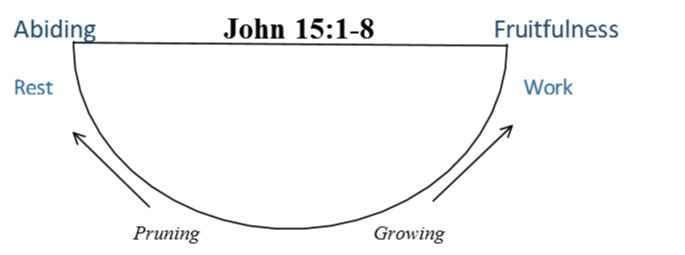
Mike Breen writes, “We cannot bear fruit if we do not spend time abiding. But we cannot simply stay put in the abide mode, for a branch that does not eventually bear fruit will be cut off and cast into the fire.”[i] He then unpacks a powerful image of how grapes were grown (perhaps are still grown?) in the first-century:
At the time of Jesus’ incarnation, a vine would be cultivated, planted,
and left to grow for three years before being allowed to bear fruit. Every
time it tried to bring forth a bunch of grapes, it would be cut back. After
the third year, the grapes would be allowed to grow on their own. By
then the branches were strong enough to support the weight of the
grapes without breaking. After the harvest, the branches were pruned
back for a time of nourishment and rest before the fruit-growing season
began again.[ii]
Likewise with our faith: Let’s get after kingdom building by sharing our faith with those in our spheres of influence and by teaching our groups for transformation toward deeper worship and bolder evangelism. But do not forget to abide in the presence of your Savior: REST. The most effective teachers are those who simply share with their groups what the Lord is teaching them through their lives and study, so be sure to allow sufficient time in your daily life for the Lord to teach you.
Imagine a pendulum swinging back and forth from “Abiding” to “Fruitfulness” which makes the semi-circle shape; thus, we have a visual of the rhythms in kingdom living. We have to find the proper balance between our work and our rest, and perhaps more importantly, our kingdom work and our kingdom rest. This truth goes double for those in local fellowship leadership positions.
We were designed to work (Genesis 2:15), so that it is right and good to work. Remember that the toil of work was a result of the Fall rather than God’s good design (Genesis 3:17-19). But, like every other good gift of God, we pervert the gift to make it an idol as a function of our sinfulness. Christ offers a corrective in John 15:1-8. Jesus says, “Remain in me, and I will remain in you. No branch can bear fruit by itself; it must remain in the vine.” So, in order to do the work to which Christ has called us, we MUST abide (see rest) in His presence (see person and work). In so doing, we will be convicted of sin in our lives, convicted of our various idolatries, become more sensitive to the Spirit’s promptings, and discern our call better. Then we put all of that into action through the work we’re called to do.
[i]Mike Breen, Building a Discipling Culture, 2nd Ed. (Pawleys Island, SC: 3DM Publishing, 2011), 92.
[ii]Ibid., 92.
Divine space is the discipleship context most readily available to us, yet it is often the context that we focus upon the least. Divine space is defined as, “Being alone with God, your Creator and Redeemer (eg intentionally sitting and enjoying His presence).”* Because this space incorporates only the individual and God, one has perpetual access to it. But because of the business of our lives with demands from work, family, church, and friends, we often jettison this most significant of spaces.
We must follow Jesus’ model, trusting that fruit will be borne by our obedience. Jesus withdrew from crowds (Matthew 14:13, Mark 6:45-46, John 6:15), Jesus commanded us to be alone at times (Matthew 6:6), and Jesus desired solitude in His most distressful moments (Matthew 26:39). While many times we learn God’s will through mentors, sermons, and group life, we must not neglect discerning God’s will through time alone with Him. My worry is that life is so hectic, we won’t take time to reflect upon how the Lord is working through our experiences.
The contemplative pathway is not everyone’s most natural spiritual pathway; nevertheless, intentional solitude should be a regular part of one’s discipleship regimen. You can pray during this time, read the Bible, just sit and listen, or take a walk and reflect on your previous week in light of God’s nature. In these moments, we will be refreshed and renewed to pour ourselves out for others. Another option from which I have benefited is to learn my spiritual pathway and then to read the biblical stories about the characters most like me. I have gained much insight into myself from that exercise.
How do we make Divine Space available to our group members? First, we must preach it to them. We must make clear the importance of spending time alone with God. Second, we must model it. Share with your group members how you utilize this space in your self-discipleship. Third, encourage your group members to take advantage of the “self-guided study” dimension of JourneyOn. I cannot overstate the value of running some theological or spiritual idea down by studying the Scriptures and reading numerous books, listening to numerous podcasts, or watching video presentations of it until it is settled in our mind. The JourneyOn strategy provides for this domain by offering your group member (and you) a list of resources on their topic of interest. Then, if they so desire, they could talk with me (or some expert if I can find one) about this issue after having studied it. I did something similar through an independent study of the “Metaphysics of Causation” in seminary which fundamentally changed my life.
However it occurs, we must be clear, as leaders, that one is not experiencing holistic discipleship if one is neglecting the Divine Space. As shepherds, we must urge our group members to engage this space.
* http://dandelionresourcing.com/2016/01/28/5-contexts-of-discipleship-infographic/